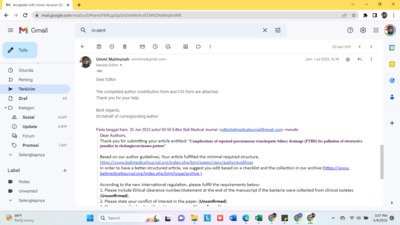Radhitya Farizky Deta Juniawan and Ummi Maimunah and Titong Sugihartono and Ulfa Kholili and Budi Widodo and Husin Thamrin and Muhammad Miftahussurur and Amie Vidyani (2022) Complications of repeated percutaneous transhepatic biliary drainage (PTBD) for palliation of obstructive jaundice in cholangiocarcinoma patient. Bali Medical Journal, 11 (2). pp. 850-857. ISSN 2302-2914
|
Text (Aretikel)
13.Complications_of_repeated.pdf Download (560kB) |
||
|
Text (Kualitas Karir)
13.Kualitas Karil.pdf Download (589kB) |
||
|
Text (Similarity)
13.Similarity_Complication PTBD.pdf Download (3MB) |
||
![[img]](https://repository.unair.ac.id/125574/5.hassmallThumbnailVersion/12.%20CRP%20author.png)
|
Image (Korespondensi)
12. CRP author.png Download (183kB) | Preview |
Abstract
Background: Cholangiocarcinoma, a malignancy of the biliary duct system, has been recognized as the second most common cause of biliary tract and primary liver malignancies. The incidence has increased in the last three decades worldwide. Percutaneous transhepatic biliary drainage (PTBD) has been considered a highly important palliative therapy for bile duct obstruction due to its high success rate and low incidence of cholangitis. However, bleeding and catheter dislodgment are still found during the procedure. This case discusses the complications of repeated PTBD stent placement as palliative therapy in a patient with obstructive jaundice due to cholangiocarcinoma. Case Presentation: A 58-year-old female presented with a chief complaint of weakness and pain on the right side of the abdomen, particularly at the site of PTBD stent installation three days before being admitted to Dr. Soetomo General Hospital. In 2017, the patient was diagnosed with cholangiocarcinomawith obstructive jaundice and had undergone PTBD procedure five times during the period of July 2017 to March 2018 due to biliary leakages. Laboratory investigation indicated elevated bilirubin, decreased potassium, increased random blood sugar, increased blood urea nitrogen, high levels of the 2-hour postprandial blood glucose, and elevated HbA1c, suggesting the conditions of cholangiocarcinoma with obstructive jaundice complicated with hypokalemia, acute kidney injury and type-2 diabetes. The blood smear also indicated normochromic normocytic anisopoikilocytosis anemia and leukocytosis. The patient improved after PTBD replacement, antibiotics treatment, packed red cells transfusion, and rehydration therapy. Conclusion: This case highlights that the complication of PTBD could occur relatively frequently and to prevent the complications in patients with post-PTBD regular medical check-up is therefore recommended. In addition, it is also critical to improve the patient knowledge on how to prevent the bleeding and to avoid the conditions that are potentially increase the chance of catheter dislodgment.
| Item Type: | Article | ||||||||||||||||||
|---|---|---|---|---|---|---|---|---|---|---|---|---|---|---|---|---|---|---|---|
| Subjects: | R Medicine > RC Internal medicine > RC31-1245 Internal medicine | ||||||||||||||||||
| Divisions: | 01. Fakultas Kedokteran > Ilmu Penyakit Dalam | ||||||||||||||||||
| Creators: |
|
||||||||||||||||||
| Depositing User: | Ika Rudianto | ||||||||||||||||||
| Date Deposited: | 28 Apr 2023 14:22 | ||||||||||||||||||
| Last Modified: | 28 Apr 2023 14:22 | ||||||||||||||||||
| URI: | http://repository.unair.ac.id/id/eprint/125574 | ||||||||||||||||||
| Sosial Share: | |||||||||||||||||||
Actions (login required)
 |
View Item |


